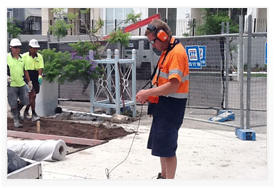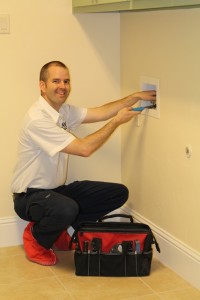Water Leak Detection
Are you experiencing unexplained high water bills?
Water leaks can be difficult to find and are often in places which are either hard to get to or difficult to trace the source. Leaks can often occur behind walls or under slabs, in sewer pipes or stormwater drains, and can be the result of a blocked drain, burst pipe or faulty plumbing fixtures.
Types of water leaks
The fresh water coming into your home runs under pressure through the mains water pipe which means a burst pipe can quickly become a huge issue in your home. The waste water leaving your home through the sewer system (everything that goes down the sink, toilet, bath, shower, etc.) and the rainwater travelling through the stormwater drains is gravity fed which usually leads to slower leaks (unless it has been raining or your have a blocked drain)
With this in mind, there are generally 3 different types of water leaks:
Stormwater leak: Is this leak only occurring when it is raining? If so, it is likely a stormwater leak.
Sewer Leak: Does the leak have a bad odour? If so, it is commonly a sewer leak.
Water Supply: Does the water bubble up? If so, it is likely a water supply leak.
Finding the leak
Apart from high water expenses, there are many other signs to look out for that could indicate that your pipes have burst or you have a broken drain.
Checking the meter
Set aside a period where you won’t need water for at least two hours. Turn off all the taps throughout your property and home, and switch off any water using appliances (such as the dishwasher, washing machine and hot water system*). Take a note of the meter reading of your home’s water meter then re-read the meter after two hours. If the reading has changed you could have a leak in the mains water pipe.

Leak Detection
Have you noticed an unexpected rise in your water bill, but you don’t know why? Maybe your basement is flooded, or your wall is suddenly wet? You may have a leak you are not aware of, and you need experienced plumbers to determine the problem and conduct a prompt and efficient repair.
You can count on our leak detection Sydney to provide prompt and efficient plumbing service any time you need it. We will be at your place at the scheduled time to get your problem resolved. Our services are available 24 hours a day, so even if there is an emergency, you can be sure that we will be at your address as soon as possible.
Commercial Property Leak Detection
Pipelines in commercial properties may cause more problems than you can expect. Closing your company for a couple of days will cause you to lose valuable time and money. On the other side, if the leaks don’t surface immediately they can be hard to pinpoint, and you will have to pay the rising water bills.
Water and Gas Leak Detection
We have been working on different projects that included leak detection for water as well as gas pipelines. No matter if you started hearing noise from your water pipes, or you started smelling the gas, don’t hesitate to give us a call.
If left unsolved for a long time, water leaks can seriously damage your property, and there will be much more costly repairs, especially if it shows up near porous surfaces like carpets, wooden floors, drywalls, etc. Because of that, it is important to regularly check your pipelines and water utilities,
Leak Detection
Water Leak Testing, Leak Detection, and Pipe Leak Repairs
DFW Pipe & Plumbing & Plumbing specializes in under slab hot or cold water leak detection and location services. We are at the forefront of our industry and take pride that we can also offer our customers various types of repair options
The Signs of a Water Leak
These include the following:
Unexplained puddles of water appearing within a building or home
Wood floors that appear to be buckling
Warm spot on the floor
Standing water outside or even a soggy lawn
Unexplained hissing or a whooshing sound usually caused by water rapidly exiting at the leak location in the pressurized pipe
A steady or sudden rise in water usage and water bill increases
NOTE:
Due to pressure limitations within the pipe, the depth of the pipe and the surface above the leaking pipe, such as a concrete slab foundation or yard line, a homeowner may not hear or see the sign(s) of a water pipe or main line leak.
What Can a Homeowner Do…
To verify a possible water leak or just to make sure there isn’t one:
Ensure that all water is off in the home; such as: faucets & fixtures, dishwasher, washing machine, etc. etc.
Repair or shut off the angle stop where there are any dripping faucets and/or running toilets as this could also be a sign of a water leak
Inspect the gauge on the city water meter, movement on the gauge would indicate a water leak. Even if the city water meter gauge is not immediately moving, note the position and wait about 15 minutes and check the meter again, if it has moved, even the slightest, this could signify a very slow leak.
Water Leak Detection & Isolation
Plumbing will commence by verifying the existence of the suspected fresh water pipe leak(s) by performing a pressure test on the water system then proceed with pinpointing the location of the leak. Utilizing Electronic Line Tracing equipment ensures that a pipe is present and the path of the plumbing pipe is traced. Air is also introduced into the plumbing pipe (if needed), to aid in discovery. Then while operating Acoustic Leak Detection equipment where the sound is electronically amplified, we continue to track the amplification of the pipe leak while tracing the presence of the pipe in the slab to the location where the leak reverberates the loudest, pinpointing the location of the pipe and the under slab plumbing leak.
Once the plumbing leak has been found, suitable repair option(s) can be recommended and estimate(s) are provided for each type of repair, where the homeowner can choose what is suitable for their situation. These pipe repair methods are mentioned below.
Electronic Leak Detection
Many homeowners are surprised to know that sound can be the key factor when trying to find a plumbing leak. When a faucet is turned on it will create a sound as the water travels through a pipe in the plumbing (very obvious sound when a fixture is turned on upstairs).
If there is a leak in a pipe, then sound will also be created when the water pours out of the leak, and this can occur even if the leak is only the size of a pinhole. Obviously with a tiny leak the sound will not be loud like an open faucet, so for us to hear the sound of water movement we use modern technology.
As long as we can isolate a system and pressure test it, then leaks can be detected using electronics. Of course the more accurately we can pinpoint a leak, the less damage required to access the leak which saves time and money.
Electronic Leak Detection Equipment
This type of plumbing service requires expert plumbing techs with years of experience in leak detection. Streamline Plumbing uses modern equipment that will amplify the sound of moving water using microphones, digital amplifiers, and filters, which allow the leaking pipe to be identified at your home.
Electronic Line Location
Locating your sewer line is no longer a guessing game because Streamline Plumbing uses the best modern equipment to locate the elusive sewer line in a very short time. Most older homes have the sewer lines buried underground and can be difficult to find

LEAK DETECTION AND REPAIR
If your home has a leak in a water pipe, drain, or main line, it’s important to call a professional plumber experienced in leak detection and repair right away. Water leaks can cause serious damage to your home and furnishings, and some can even cause health hazards.
Plumbing Detect Leaks?
Visual inspection— This is what we start with to see if there are any signs that point to the location of the leak.
Sewer camera inspection— A small camera on the end of a device like a plumber’s snake is pushed through the pipes to find out where the leaks are.
Electronic leak location — A low-voltage device picks up and amplifies the sounds that leaks make. We can use electronic detection to find even small pinhole leaks in pipes and lines.
Pressure test — This can be done on the whole water system and can also be used for detecting leaks in sewer lines and gas lines.
Plumbing Repair Leaks?
Spot repair — The site of the leak is exposed for spot repairs. This could be done by opening up the foundation slab, accessing the pipe through a wall, or digging up a spot in the yard.
Re-piping — If a whole pipe or line is in bad condition, it can be replaced entirely.
Epoxy pipe coating — We only recommend pipe coating in unique situations, like patching small leaks in yards where plumbing runs under retaining walls. This method involves using an epoxy resin to coat the inside of an existing pipe to patch it. If the pipes are not in perfect alignment or if there is a low spot in the line, epoxy pipe coating usually isn’t a good choice.
Pipe Bursting — Pipe bursting is a method of repair where a pipe sleeve is placed in the pipe then pressed against the walls of the existing pipe by a balloon. Pipe bursting is only used in select instances. Improper sloping of a pipe and pipes that are not in alignment cannot be repaired using this technique
The most effective repair method for yard leaks is to dig down to the pipe to replace the bad section. If a leak is repaired by a skilled plumber who uses quality materials, you’re unlikely to have a problem again. No matter where the leak is, our policy is to use the best method of repair to fix the problem for the long-term, while keeping disruption of your life to a minimum.